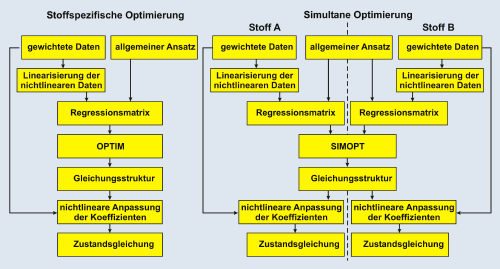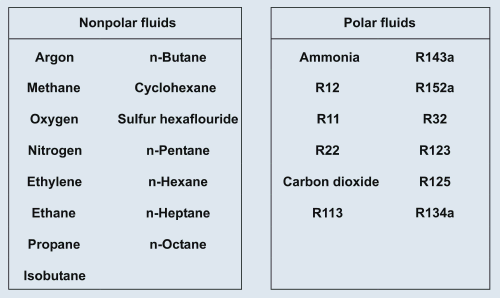Both in chemical industry and in chemical engineering a large number of fluids is used. For an efficient design of plants and apparatuses it is necessary to know the thermodynamic properties of these fluids. But for only a few of them enough reliable measurements of thermodynamic properties exist to develop an individual reference equation of state based on these data. Nevertheless, there is also a large demand for reliable values of thermodynamic properties for other substances. To be able to provide these values, we have developed a method to optimize equations of state for different fluids simultaneously (Span et al.).
The idea
In the algorithm of the simultaneous optimization, data sets of different fluids are included to develop a functional form that yields on average the best results for all considered substances. If the considered substances are representative for a physically similar group of fluids, it is possible to fit the coefficients of the functional form to other fluids of this group.
The idea is that one and the same functional form of an equation can be used to describe the thermodynamic properties of several substances, if there is a certain physical similarity among the substances. Furthermore, it is prevented that the equation will be based on incorrect trends of a single data set in scarcely measured regions, because of the simultaneous consideration of data sets for different fluids. The coefficients of the equations are fitted individually for every single substance. Hence all equations have the same functional form, but a substance specific set of coefficients.
In the following figure the procedure of the individual and the simultaneous optimization is presented in a simplified chart. Currently, there are two different applications for the simultaneous optimization: the development of "short" equations for technical applications and the development of equations of state of medium length with certain characteristics of reference equations.

Comparison of the individual and simultaneous optimization procedure (with only two substances included) to develop a functional form of an equation of state.
Simultaneously optimized "short" equations for technical applications
With the 12-term equations of state for technical applications a new class of equations was established. Previous equations of state, which achieved reasonable technical accuracy, are notedly longer (e.g., the Bender-equation with 19 terms). If these equations are fitted to limited data sets of suboptimally measured substances, intercorrelations often arise between some terms and hence the calculation of caloric properties becomes unreliable. Even thermal properties cannot be reliably calculated with such equations outside the region the equation was directly fitted ("extrapolation").
According to this, the advantages of the simultaneous optimization become obvious. The development of functional forms with data sets for different fluids, used at the same time and the low number of terms cause the notedly higher stability of the new equations. Data of thermal as well as of caloric measurements are included in the entire considered region, even if they are only available in certain regions for the corresponding substance. The new equations provide reliable values for the thermal as well as for the caloric properties, even for substances with a very limited data set. Relating to the extrapolation behaviour it could be ascertained that the short simultaneously optimized equations achieve better results than the previously released technical equations. More information is given in (Span und Wagner).
Such short simultaneously optimized equations of state were first developed for two large groups of substances, namely for "polar" and "nonpolar" fluids. In the following table the substances are listed, for which we developed such short equations of state. The equations and its coefficients can be found in (Span und Wagner) (nonpolar fluids) and (Span und Wagner) (polar fluids).

Short simultaneously optimized equations of state were developed for the substances listed.
In the meantime, coefficients for these two forms of equations of state have been determined for a greater number of substances; see the software FLUIDCAL for those substances that are based on equations of state of Lemmon and Span and of Bonsen.
Simultaneously optimized equations of state as reference equations
For the development of longer and more accurate equations of state with reference characteristics, the simultaneous optimization can be a reasonable alternative for the individual optimization, too. As an example it can be referred to the light hydrocarbons of the homologous series of the alkanes, in particular iso- and n-butane. For both substances there are partly very accurately measured data, but for both substances there are also regions, in which non or only very few reliable data exist. As the two fluids have a large industrial importance, equations of state for the butanes were developed by using the simultaneous optimization (Bücker und Wagner). For the optimization not only the data sets of the two substances were considered, but also the considerably more extensive and very accurate data sets of ethane and propane, which belong to the light alkanes, too. The aim of the project was to reproduce the partly very good data of the butanes possibly within their uncertainty, while the use of the data sets of ethane and propane in scarcely measured regions assures a reasonable course of the calculated properties. With 20 to 25 terms the equations are settled between the short simultaneously optimized equations for technical applications and the individually optimized reference equations of state with regard to their length.